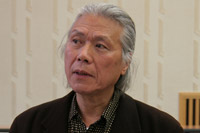Toshiaki MINEMURA
Examination Review
If there is any essential difference between print and painting, though making a sharp distinction between them may not be very important, I suppose that a special characteristic of print art is that it will be completed at the time of being compressed or fixed to a certain level when printed or pressed. On the other hand, painting (especially, oils), theoretically speaking, can leave a limitless room for addition or deletion, which, therefore, met modern artists' demands for excessive freedom or self-expansion; print art (and photography) leaves a certain level unaltered or dares to do so, even if possible to alter the level, once a print is completed by the decisive intervention of external elements, such as print and an optical or electronical framing. This seems to be an exquisiteness of print art.
In the current art world, in which non-completeness, non-restrictiveness, or alteration of artwork is welcome, the heteronomous dimension (time, space, matter, or phase) beyond artists (or, creators) in print art could be evidence of supposition that print art is an inflexible, non-modern expressive medium. But, contrarily, that is because the very nature of print art (and photography) theoretically must be a potential to develop as a promising means for post-modernist art.
This is how I interpreted the reason that the grand-prix pieces, despite being apparently old-fashioned, let me feel an individual charm and freedom rarely given by oils. The work (unit of two pieces), which I guess must have been made for this year marking the bicentennial anniversary of the birth of Andersen, the Danish author of “picture books without pictures,” judging from the titles and pictorial content, is successful minute prints securing the unlimited, novelistic space of imagination with a mooring rope of lines and images. What I especially rated high is that these illustrations have never indulged in whimsical fantasy and lines. I think that they are filled with an open sense, released not from the possible freedom and alteration particular to oils but, contrarily, from a compressed moment of the time and space and expressive manner sensed in something like an icon laboriously carved on a glass surface, or from a fixed dimension like a fossil.
When compared with this grand-prix piece full of medieval light (which comes from the depth of the picture plane, contrary to the case of modern painting), the semi grand-prix piece is highly modern, and is like an oil. With the strong smell of the possibilities of addition, alteration, or expansion, the piece is actually filled with a modern and contemporary freedom. The work, if not a print but an oil painting, would have looked commonplace, but actually, it seems to have kept an artistic balance thanks to the technical inconvenience of print art.
The works by GOTO Fumiko and KOBAYASHI Takayuki (jury award winners), which seemed to be made by treating digital images with computer, looked the most remarkable to me. Both pieces drew my attention, not because their manner of using digital or computer media was refreshing to me, but because they have broken off the connection with the blind faith in freedom as experienced in oil, that is, the expression of aura of being a creator. Particularly, Goto, shows an unquestionably excellent treatment of icons penetrating multiple spaces, as if he had thrown off the icons (how polysemic, beautiful the image of“thrown off” is). Strangely, it seemed to me that those pieces using the latest media of art seem to have an unexpected affinity with the most medieval grand-prix piece. I wonder if that is because both pieces have worked the heteronomous nature, as if they left everything about the will to create to the certain level without any hesitation. Here, that open sense, an inevitable part of distinguished art, must have been released.
